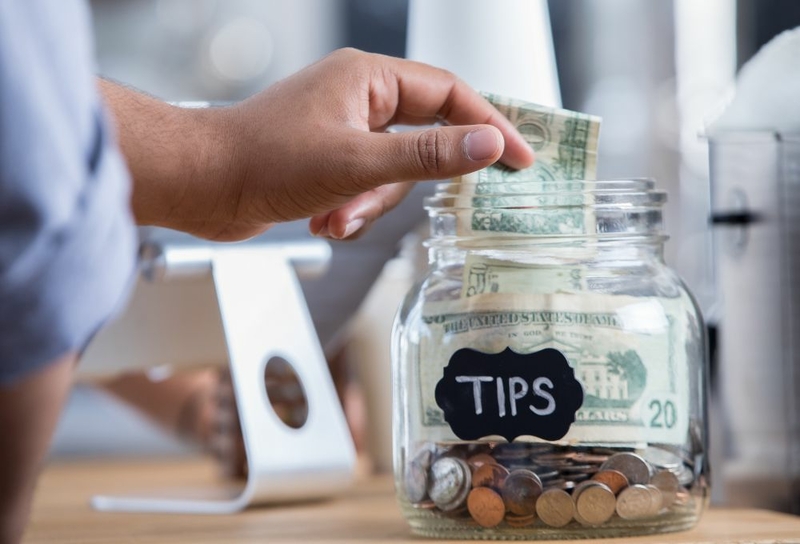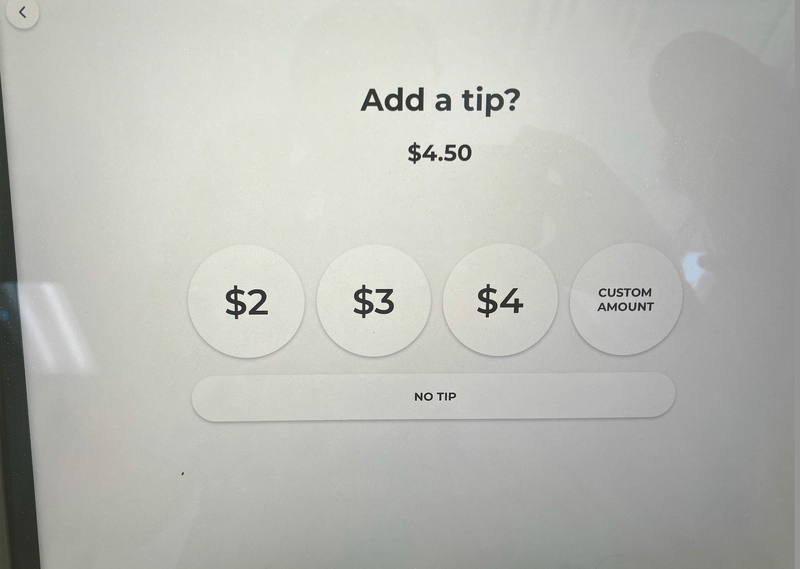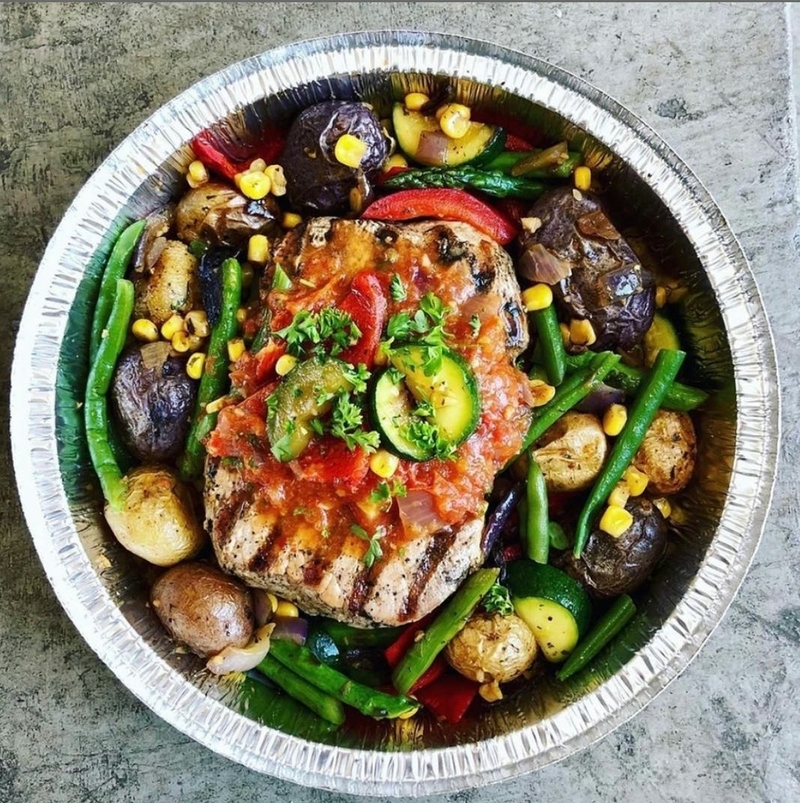Do we really need to tip 44% for a cookie?


I ordered an iced coffee (lots of ice, no sweetener, just a touch of milk — picky, picky picky). It cost something like $4.01, so I handed him a five and told him he could keep the change.
“Are you sure?” he asked. When I said yes, please keep it, he said, “Thanks so much!” He seemed to really mean it.
That was a switch! When was the last time you didn’t feel pretty much coerced to tip at a food-beverage counter?
For example, the other day, I went to a cookie shop and ordered a gourmet cookie that cost $4.50. The point-of-sale (POS) machine prompted me to tip $2, $3, or $4. There were also “no tip” and “custom amount” options.

Breaking it down, the minimum suggested tip was $2 for a $4.50 cookie — that’s a 44% gratuity. This, at a self-serve kiosk where you key in and pay for your order. A team member behind the counter boxes the cookie, calls your name, and hands the box to you.
Like many customers, I tip counter help here and there, especially when some service is truly involved (like when asking them to craft a coffee drink just the way I like it).
But at the cookie place, the suggested 44% tip gave me great pause and made me wonder: Why is this happening? And where will this stop?
Bucking the trend: The Grateful Chef
The POS tip “ask” has become pretty much standard in almost any prepared food/beverage counter-service situation. But you know who doesn’t ask for a tip? The Grateful Chef.

If you don’t know about The Grateful Chef, you should. Chef Brandy Shayan and her business partner John Cornish offer prepared dinners for pick-up. The menu, which changes each week, goes live on Mondays at 10:30 a.m. Customers place their orders early in the week, then pick up their food on Thursday or Friday. The refrigerated meals take about 35 minutes to warm in the oven once you’re home. The meals are creative and expertly and precisely prepared. At $25 for two servings, they’re a bargain, especially compared to dining out.
This is the type of place where owners could easily build a tip option into their POS system, but they don’t. I asked co-owner John Cornish the reasoning behind this.
“As you might imagine, we have contemplated [adding a tip option] over the years. Ultimately, we have decided that we would rather pay our employees significantly higher than the industry standard as well as offering health insurance, etc., in lieu of asking our customers to tip.”
Cornish adds that he completely understands that some businesses in his industry cannot afford to do this, and that tipping is the best way to attempt to get their employees up to a living wage. He also says that he personally is very happy to tip well. “That said, I do believe it has started to get out of hand in certain circles. I have even started to see it when I purchase clothing online!”
“The way our business is structured, I don’t believe we do anything in our customer-facing environment that generally warrants a tip,” he explains, adding that although a few customers have asked if they can tip, “We have had an equal amount thank us for being one of the few places left where it isn’t right in your face and feels mandatory.”
Some thoughts on ‘guilt tipping’
So, what’s going on with this ubiquitous POS “tip ask” — especially in places where employees really aren’t doing anything that traditionally warrants a tip? In many cases, I suspect that we’re being asked to tip not for services performed, but because many of these workers are underpaid.
It’s part of a trend called “guilt tipping,” which as Gene Marks at The Guardian put it, “escalated during the pandemic when we wanted to congratulate ourselves for supporting those service workers for doing their jobs in such terrible times while we watched Netflix.”
So, now that the pandemic is over, can we stop it with the POS guilt-tipping? I’ve researched this for days, and I have found no standard consensus on this among restaurant-industry reporters and etiquette experts. Even Cornell University professor Michael Lynn, one of the leading experts on tipping habits in the U.S., told CNN, “I don’t know how much you’re supposed to tip and I study this.” (Italics mine.)
In the midst of all this confusion, this underlying issue persists: most counter-service employees are still underpaid. I talked with a manager at the cookie shop, and she said that the starting wage for a baker was $11 per hour (not considered a living wage in Iowa, according to MIT). However, she also told me that the team made “quite a bit” on tips, which were put into a tip pool to be shared among the bakers, team leaders, and management.
The question we’re all asking, of course, is why don’t owners simply pay their help a higher wage and increase the price of the menu items to cover it? The manager I spoke with at the cookie shop was not able to answer that for me.
I suspect it has to do with whether or not customers would be truly willing (or even able) to pay, say, $5.50 instead of $4.50 for a cookie. Or $10 for a sandwich instead of $8. Or $6 for ice cream instead of $5.
The owner of a Jeremiah’s Italian Ice franchise in North Carolina explained that the voluntary point-of-sale tip system “helps us keep our menu prices low and widely available for everyone,” WSOC-TV reported.
So, if I understand this correctly, those who can afford it and willingly tip at a POS terminal help keep menu prices down for those who wouldn’t otherwise be able to afford this kind of fast-casual food, while also helping the staff earn a better wage.
I’d imagine that anyone who is reading this wants everyone to be able to afford a gourmet cookie or a fancy ice cream cone now and then; we also all want everyone to make at least a living wage. Yet I find it hard to believe that that the POS tipping model is the best we can do — which is why I absolutely adore The Grateful Chef for figuring out a better system that works for everyone.
What to do when prompted for a tip
As I mentioned, there is no consensus about whether or how much to tip when it comes to counter service. Many sources I read agree that, unlike with table service, tipping for counter service is still voluntary (even though it doesn’t feel that way at the POS screen). Others say a gratuity is nice if you’re a regular customer, or if you’re getting some level of expertise or service. How much? Again, there’s no consensus — but certainly, no one I read advised consumers to tip 44%.
The advice I appreciated the most on the subject was in this CBS article, which quoted a professor of Hotel Administration at Cornell University:
“Customers should tip in line with their own values and motivation.”
That’s right. You do you. I’ll simply add that whatever you decide, do so deliberately, without feeling rushed. When faced with the options, take your time and push the button you really want to push. And then, enjoy the cookie.
P.S.: I’d love to hear about other places that have figured out a way to buck the POS tip-ask trend. Feel free to share in the comments section.
Wini Moranville is the author of Wini’s Food Stories on Substack. Her column is republished here as part of the Iowa Writers’ Collaborative.
Editor’s note: Please consider subscribing to the collaborative and its member writers to support their work.








